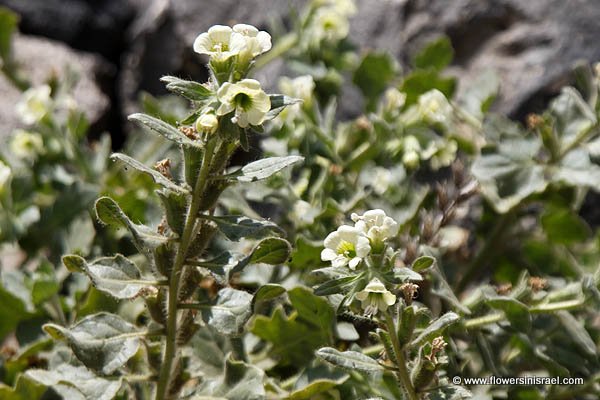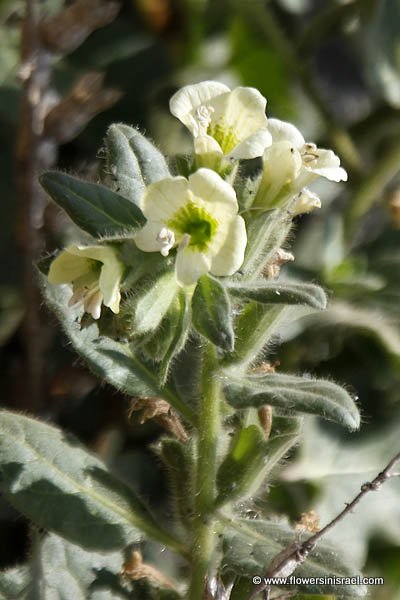Hyoscyamus aureus sensu Gouan, White Henbane, Russian Henbane,
Hebrew: שיכרון לבן, Arabic: البنج الأبيض
| Scientific name: | Hyoscyamus albus L. | |
| Synonym name: | Hyoscyamus varians Vis., Hyoscyamus major Mill., Hyoscyamus aureus sensu Gouan, non L. | |
| Common name: | White Henbane, Russian Henbane | |
| Hebrew name: | שיכרון לבן | |
| Arabic name: | البنج الأبيض | |
| Family: | Solanaceae, סולניים |

|
| Life form: | Annual | |
| Spinescence: | Flowers | |
| Stems: | Up to 40-50 cm; erect, basal branching, villous | |
| Leaves: | Alternate, entire, orbicular or ovate, dentate margin, stipule absent | |
| Flowers: | Unbranched spike, sessile hermaphrodite flowers; white, yellow; trumpet shape, 2/3 of petal length is fused leaving 5, apical distinct lobes; spinescent | |
| Fruits / pods: | Dehiscent circumscissile capsule; brown; 100-300 kidney-shaped greyish brown seeds, 2mm; | |
| Flowering Period: | March, April, May, June | |
| Habitat: | Hard rock outcrops | |
| Distribution: | Mediterranean Woodlands and Shrublands, Montane vegetation of Mt. Hermon | |
| Chorotype: | Mediterranean | |
| Summer shedding: | Ephemeral |

Derivation of the botanical name: Hyoscyamus, Hyoskyamos, from the Greek hys, hyos, "pig" and kyamos "bean", allegedly, because pigs can eat the herb without damage. albus, white. varians, variable, varying. major, comparative of magnus: large, great, high, extensive; larger. aureus sensu Gouan, aureus, golden yellow; sensu, in the sense of; Gouan, Antoine Gouan; golden yellow in the sense of Antoine Gouan. The Hebrew name: ,שיכרון, shikaron, from Aramaic: שכרונא (= a soporific drink) — whence also Arabic: saykuran ( = henbane) — derived from שכר ( = he got drunk, got intoxicated).
It is only mentioned in one place in the Bible (Joshua 15:11), in conjunction with the biblical place-name Shikrona in Judea. Shikrona is the Hebrew word for Henbane. Hyoscyamus contains hyoscyamine, used since antiquity as both a sedative and a love potion. The ancient Egyptians smoked henbane for their dental problems. Hyoscyamus albus was the superior means in ancient times of inducing a trance-like state. Many oracles and soothsayers made use of it to assist in cultivating their prophecies. It was known as the "dragon plant" of Gaia, the ancient earth oracle, the "Zeus bean" of the oracle of Zeus-Ammon of late ancient times and the Roman Jupiter, and the 'Apollo's plant" of Delphi. It was called also Apollinaris after Apollo, the God of the fortune-telling. It was commonly known as white henbane in the seventeenth and eighteenth centuries. Much earlier it was described in detail by Dioscorides (ca. 40-ca. 90 CE.), who characterized it as the species with the greatest medicinal value, and used it to procure sleep and allay pains (4.69). Pliny the Elder (23-79 CE) writes that all kinds of Hyoscyamus cause insanity and giddiness, and he writes in his book Natural History, Book XXV.33-35: To Hercules too they ascribe the plant which is called appolinaris by some, altercum by us Romans, but by the Greeks Hyoscyamos ("pig's bean"). In the Middle Ages the drug was the most frequently used anaesthetic for operational interferences. The drug played a certain role as murder poison, as William Shakespeare (1564-1616), in its “Hamlet” reports on the murder at the Dane king: 'Sleeping within mine orchard, My custom always of the afternoon Upon my secure hour thy uncle stole, With juice of cursed hebenon in a vial, And in the porches of mine ear did pour The leprous distillment.' The head-dress of the Jewish High Priests' was modeled upon the capsule of the Hyoscyamus and Josephus Flavius was the earliest, who described it (Antiquities, Book III, 7:6): "The high priest's mitre was the same that we described before, and was wrought like that of all the other priests; above which there was another, with swathes of blue embroidered, and round it was a golden crown polished, of three rows, one above another; out of which arose a cup of gold, which resembled the herb which we call Saccharus; but those Greeks that are skillful in botany call it Hyoscyamus. Now, lest any one that has seen this herb, but has not been taught its name, and is unacquainted with its nature, or, having known its name, knows not the herb when he sees it, I shall give such ,as these are a description of it. This herb is oftentimes in tallness above three spans, but its root is like that of a turnip (for he that should compare it thereto would not be mistaken); but its leaves are like the leaves of mint. Out of its branches it sends out a calyx, cleaving. to the branch; and a coat encompasses it, which it naturally puts off when it is changing, in order to produce its fruit. This calyx is of the bigness of the bone of the little finger, but in the compass of its aperture is like a cup". This I will farther describe for the use of those that are unacquainted with it. Suppose a sphere be divided into two parts, round at the bottom, but having another segment that grows up to a circumference from that bottom: Suppose it become narrower by degrees, and that the cavity of that part grow decently smaller, and then gradually grow wider again at the brim, such as we see in the navel of a pomegranate, with its notches. And indeed such a coat grows over this plant as renders it a hemisphere, and that as one may say, turned accurately in a lathe, and having its notches extant above it, which, as I said, grow like a pomegranate, only that they are sharp, and end in nothing but prickles. Now the fruit is preserved by this coat of the calyx, which fruit is like the seed of the herb sideritis: It sends out a flower that may seem to resemble that of the poppy. Of this was a crown made, as far from the hinder part of the head to each of the temples; but this ephielis, for so this calyx may be called, did not cover the forehead, but it was covered with a golden plate, (14) which had inscribed upon it the name of God in sacred characters. And such were the ornaments of the high priest. Bible resources:


|